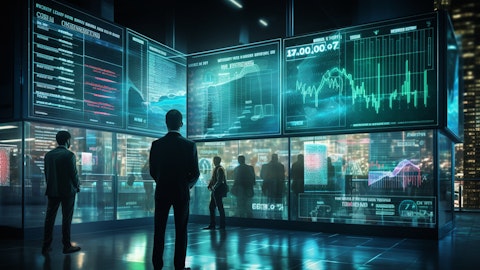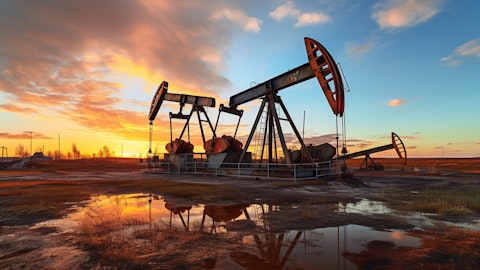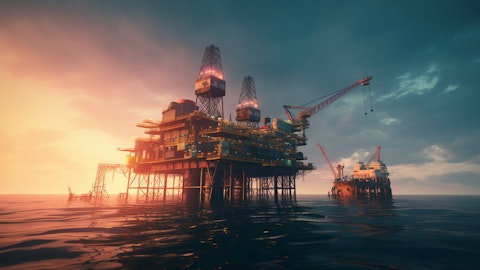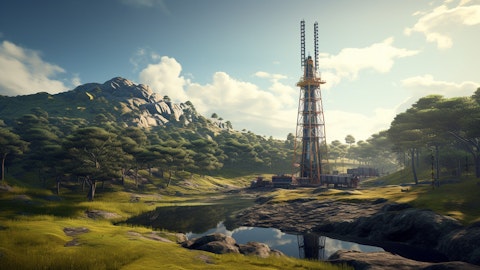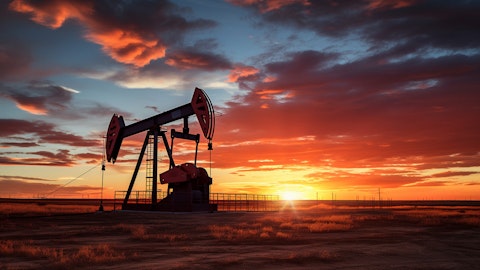And so our teams have done a great job. I don’t think we’re going to see this profitability increase that we saw ’23 versus ’22. But at the same time, I think it’s steady and this business is going to throw off a lot of free cash.
Andrew Smith: Yeah, I would reiterate that. I would just say that from this point forward through the year and we view it today, we look at both revenue and cost being relatively steady.
Derek Podhaizer: And maybe just a quick follow up. The cost per day, but what was the lead driver of that step up?
Andrew Smith: Yeah, we have — there’s a lot of things going on at the end of the year, truing up some cost estimates and things like that. Nothing in particular that was significant. I mean, again from quarter to quarter, you can have a bunch of things bumping around in there, whether it’s working capital or insurance reserves and all that stuff. That was our workers’ comp. So you’ve got those items that come through in the fourth quarter. Sometimes it just causes a little bit of a change. But I would say nothing that I would point to that I would say is hugely significant.
Derek Podhaizer: Thanks for all the color, I’ll turn it back.
Operator: Your next question comes from the line of Jim Rollyson with Raymond James.
Jim Rollyson: Good morning, guys, and great job on the quarter and free cash flow and returning free cash flow. Andy, just a couple of questions around the rig side. So you’re 122 in January or 122 today. We’re halfway through the quarter. And obviously, guidance is for 120, so implying things come down. Is that — just kind of curious what you’re seeing on the rig side around the gassy basins, similar to what you’re doing on completions, are you looking at moving any rigs around out of gassy basins into oily basins? Just maybe a little color on that.
Andy Hendricks: Sure. I think for now, our view is that the oil basins are going to stay relatively steady. And so, you know, the rigs that we have working in those basins, which is really about 70% of our rigs are in oil basins. But even though 30% of our rigs are operating in gas basins, some of those rigs are on gas liquids and not dry gas. So it’s not full 30%. It’s probably closer to 20% to 25% that are drilling dry gas. So I think you’re going to see a relatively steady in those oil and gas liquids basins for us. In natural gas, sure. We’re anticipating some softness. We could be down maybe three rigs over the next few months, maybe five rigs, based on where natural gas is trading today. But again, that’s off a base of 122 rigs.
And then you’ve got a longer-term outlook as we get closer to LNG takeaway needs. So could there be some softening in natural gas? Sure. Is it going to be a big impact for the company? No. Is it going to change margin profitability? No. We’re performing really well. We don’t have a need to reduce rates. We’re not likely to necessarily move those rigs out of the gas basins because if you look at the longer term, we’re going to probably need them there in 2025. So I think it’s still — I’d still call that relatively steady, even with some potential softening in the gas base.
Jim Rollyson: Got it. That’s helpful. And you mentioned rig upgrades. Normally when we’re in an upward trajectory market, you guys are reactivating rigs, upgrading rigs and getting a lot of that covered or all of that covered on term contracts. Can you talk about what the specific rig upgrades you’re doing for specific customers and kind of how you see capturing that capital back and the return on that capital in this kind of market where we’re more steady instead of upward moving?
Andy Hendricks: Yes. One of the upgrades I’m really excited about is some of the upgrades and latest technology in terms of process automation packages that we’re putting on the rig. This is really a capital light upgrade. It had to do with electrical systems and software. And when we layer that onto a rig, we add automation capabilities to improve performance and consistency of the drilling operations. And so we’re going to go through a steady pace of doing rigs and transforming that. And our customers are excited about that. They want this. This is something that they’re asking for and in demand. But again, it’s a capital light type upgrade.
Jim Rollyson: Got it. Thanks. I’ll turn it back.
Operator: Our next question comes from the line of Stephen Gengaro.
Stephen Gengaro: Thanks. Good morning, gentlemen. A couple of things for me, and it’s probably a long question. So I apologize. But when we think about the wellsite integration on the frac side, I have got like two or three questions around that. And one is can you give us a sense for the percentage of assets that are kind of at the high end of integrated services versus the low end. And I’m not sure if there’s a way to kind of give us any color around the profitability gap and I know legacy NexTier provided some color on that. And then just the final part of that long question, is that any impact on your ability to do that with the M&A of your customers or the larger customers more or less willing? And how should we think about that?
Andrew Smith: Yeah, I’ll answer the first part of that, and I’ll let Andy talk to the customers. The harder question. Yeah, right now, in terms of the integrated wellsite offering and sort of how that works across our fleet, where you think about a heavy concentration versus , it’s about 50-50 on the fleet. We saw a lot of opportunity to push more that integrated offering across our work in the pressure pumping space.
Andy Hendricks: Yeah, in terms of customers and M&A, we all can see that there’s been huge wave of consolidation from the E&P customers. And when that happens, you’re going to get a pause in activity. And for some customers that we’re working for that might be a pause for us. For some other customers, it might be kind of a neutral for us in the near term. But you’re going to get a pause until they decide what resources they want to use and what they want to do going forward from an operation standpoint. But when they evaluate that, I think, we are well positioned with our ability to integrate the necessary services to enhance performance on the completion side and even on the drilling side with the new technologies that we’re rolling out. So I think we’re in great shape for this wave of consolidation that’s happening on the E&P side.
Stephen Gengaro: Great. Thank you. And then just a quick follow-up to that. When we think about underlying price, not sort of a mix issue from increased offerings, but underlying frac prices, are — if we modeled something that was kind of flattish from current levels for ’24, is that something you’re comfortable with? Or how do you think about that?
Andy Hendricks: Yeah, we acknowledge that there was softening in completions pricing and rig pricing in H2 last year. But I think from where we are this year, it’s going to be relatively steady for us. And I want to qualify that for us because we are seeing some whitespace as we discussed earlier, and we are moving some assets. But part of that is just because we don’t feel like we want to take lower rates. And so we’re going to work to protect pricing in the markets and protect our margins in the markets. And so for us, I think it’s relatively steady.
Stephen Gengaro: Great. I appreciate all the color. Thank you.
Operator: Our next question comes from the line of Saurabh Pant with Bank of America.
Saurabh Pant: Hi. Good morning, Andy and Andy. If you can spend, Andy, a little time on your e-fleet strategy. I’m thinking from the perspective of leasing versus buying and then also from a perspective of when you’re buying something, how important it is in your mind to own that technology versus just buy it off the shelf from a window? And then related to that, how should we think about power solutions in the context of that 80% of your fleet is going to be natural gas fired by the middle of ’24? How much of that do you think is being supported by power solutions at that point?
Andy Hendricks: So I’m going to I’m going to start, and then I’ll let Andy Smith talk about this as well from a business growth profitability standpoint. When you think about the e-fleets, we certainly realize there’s customer demand out there. We want to have those technology offerings as well. There is improved profitability to be able to do that. And so we are investing in e but also some other technologies as well, not just the e. So yes, we are working with a couple of different suppliers of electric frac equipment to look and see how the performance is on different types of equipment. And we’ve tested other equipment in the past. We do request some changes when we get some of this equipment delivered. So what we offer may be slightly different from others using similar equipment.
But we have some experience and we’re excited about this offering. We’ll continue to evaluate who our suppliers should be and who we want to work with going forward. But suffice to say that we are moving in that direction. And I’ll add that we also have a drilling company that has a great history of operating over 1,000 AC induction motors. We also have electrical engineering company that has experienced building high voltage control systems for AC induction electric motors, including for electric frac. And so stay tuned. And we’ll keep you posted on how this is going to evolve from a technology standpoint. But we’re in it. That’s for sure.
Andrew Smith: Yeah, right now, in terms of power solutions supporting our own work, right, about 40% of our work out there is supported by power solutions, and we’ve got opportunities to grow that in the current year.
Saurabh Pant: Okay. Fantastic, Andy, and thanks for joining us on the technology side. So we’ll stay tuned on that. And a quick unrelated follow-up for me on the synergy side. By the way, really good progress. I don’t know if Kenny is on the call or not, but a shoutout to him. Definitely, doing a fantastic job. And I think Andy Smith, I think you said on the call in your prepared remarks that you expect at least $200 million. So I just want to emphasize the at least and see now that it’s been five months, so a little more than five months since you closed the merger, how do you look at any potential upside to that $200 million or maybe accelerating that from 18 months to maybe you realize not sooner than 18 month?
Andrew Smith: Yeah, look, we’ve got — as you can imagine, there’s a whole range of items included in the bucket that we’ve been active in terms of synergies. And we’ve kind of gone through the market since we’ve closed and the market’s been sideways to potentially down a little bit. Probably, when we first started talking, we said, look, there’s a lot of synergies and we’re going to get out of this business. Some of it can be a little obscured by the market pricing. We are not — that’s not how we’re looking at it internally. Internally, we are — there is lot of rigor around making sure that we prove out each one of these is actually hitting our income statement. So we feel very good about that $200 million. I think in an improving market, that number only goes up, but I don’t want to guide to a higher number than that, right now. But I think as the market improves, the benefit of those synergies only increases over and above that $200 million.
Andy Hendricks: Saurabh, as you mentioned, Kenny and the team are doing a great job. There’s a number of different teams that are looking at different aspects. We’ve talked about the different buckets in the past, whether it’s increasing revenue, supply chain or some cost savings, and we still have levers to pull on all those and we’ll continue to work at it.
